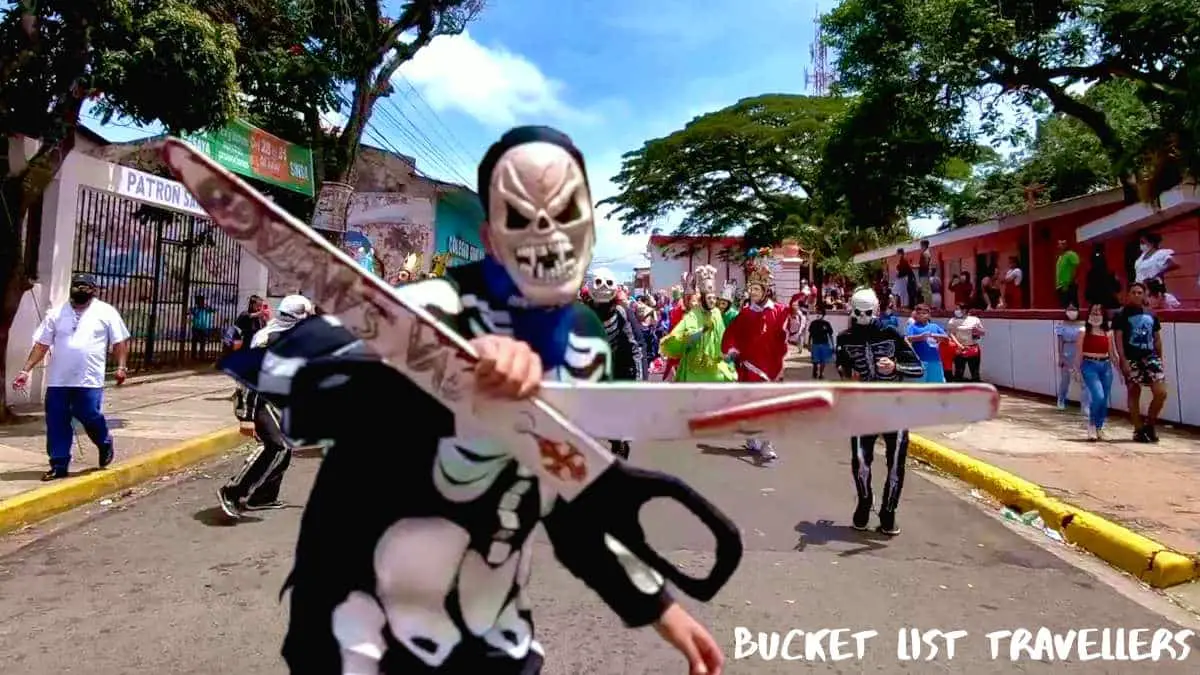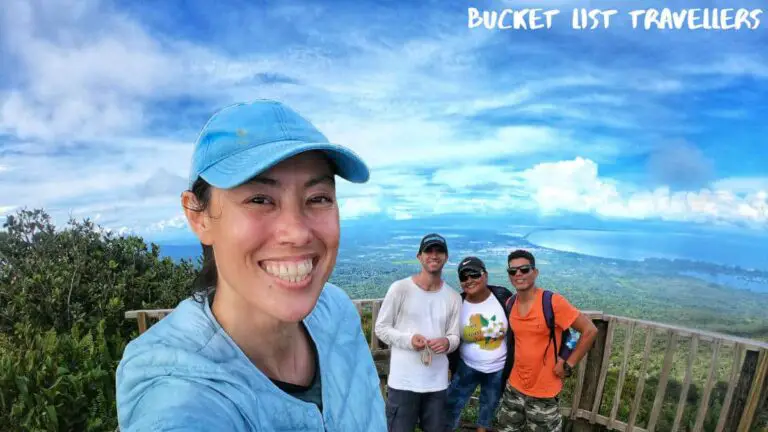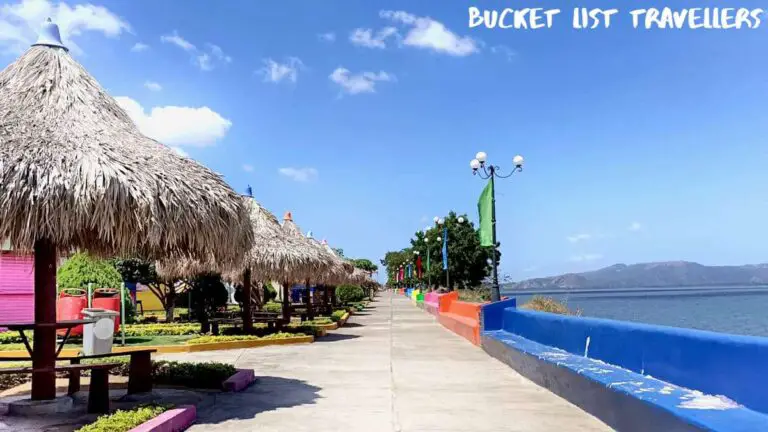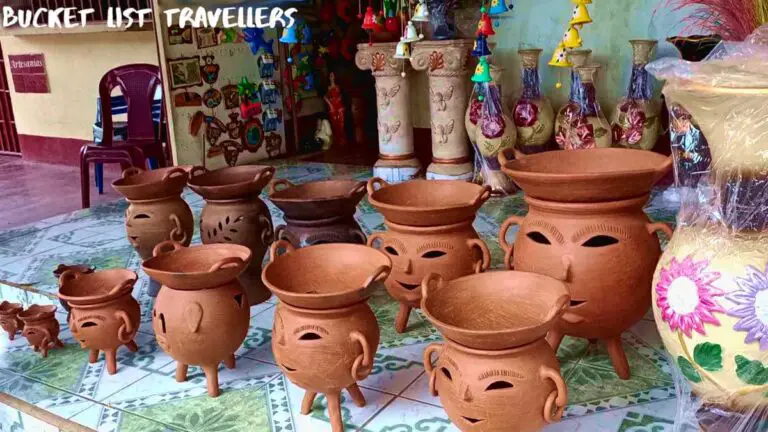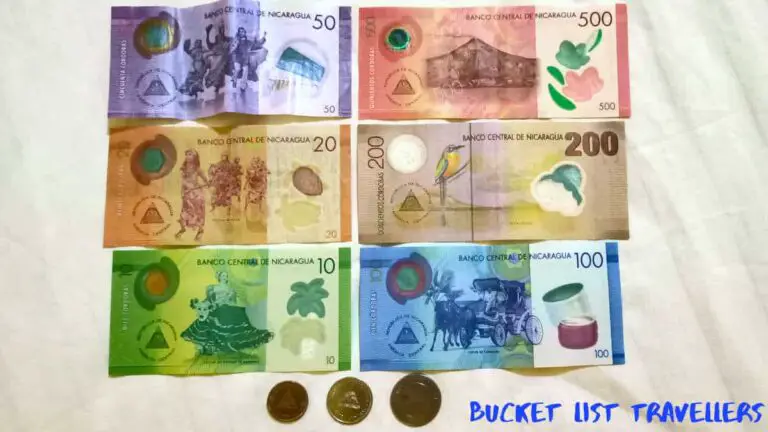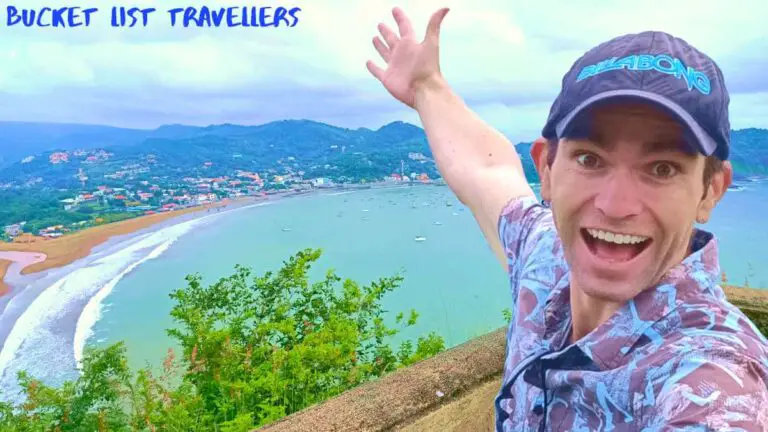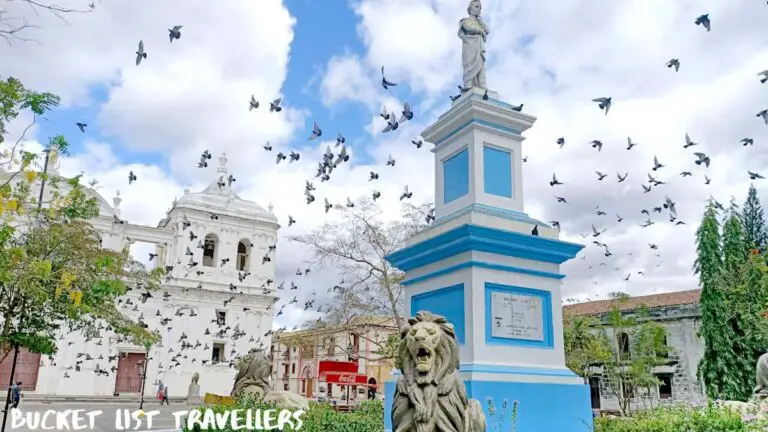Tope de los Santos is a vibrant Nicaraguan festival in the city of Jinotega. The Fiestas Patronales or Patron Saint Festivals in Nicaragua are a MUST for your Nicaragua Travel plans! They are a big affair and the Tope de Los Santos Jinotepe in 2021 was a spectacle! The patron saint festival of Jinotepe Carazo features not only one but three saints; San Santiago, San Marcos and San Sebastian! The festivities also had plenty of dancing, with the scary La Muerte Quirina, colourful Los Diablitos and other traditional dancing.
In this Nicaragua Travel blog we share the Tope de los Santos experience. We also delve into the meaning behind this fascinating part of Nicaragua culture!
Plan your trip: Here are our Nicaragua top recommendations:
Activities: book your Nicaragua Tours with Get Your Guide.
Accommodation: we use Booking.com to find the best hotels.
Private Transfers: Pacific Tours,
Flights: find cheapest flights with cashback on WayAway.
Airport Lounge Access: start your holiday the right way with Priority Pass.
Travel Medical Insurance: SafetyWing Nomad Insurance is the ideal choice for long-term travellers and digital nomads.
Travel Banking: Wise makes global travel banking seamless and affordable.
About the Nicaraguan festival Tope de los Santos
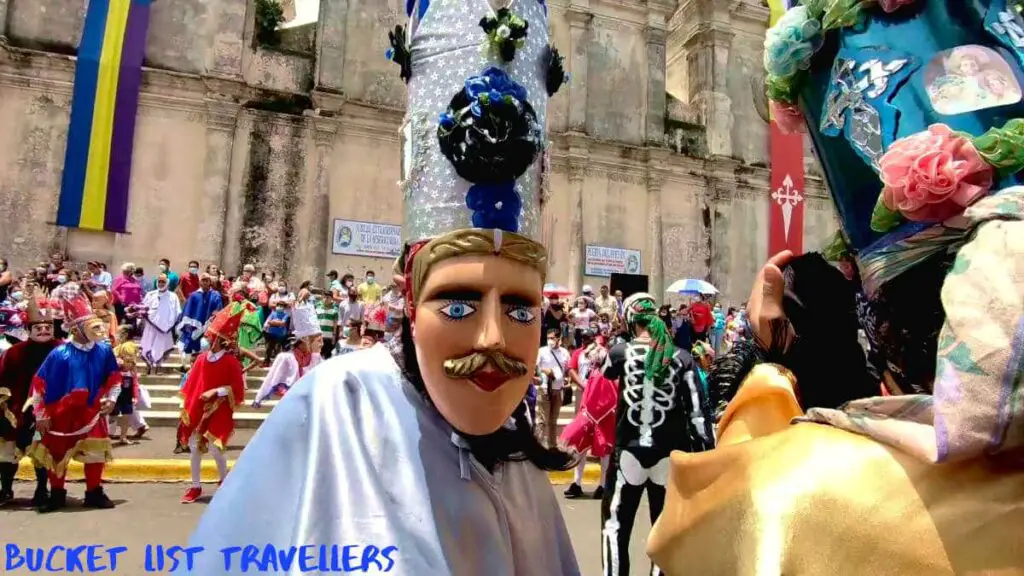
Tope de los Santos is one of the major Catholic religious festivals in the department of Carazo in Nicaragua. This Nicaraguan festival is a celebration in honour of the patron saints of three of the most important cities in Carazo – Diriamba, San Marcos and Jinotepe. On the day before the feast of each patron saint, statues of the saints leave their churches. The statues are paraded through the streets and the three saint statues meet. El Tope de los Santos is the name of this event. The English translation of this festival is “The Parade of Saints”. The festivities include music, dancing, fireworks and the handing out of traditional food as well as more sombre activities such as a mass and eucharist. The festivities are an integration of the indigenous rituals with Catholicism, creating a unique blend of the two cultures.
When is the Nicaraguan festival Tope de los Santos?
Tope de los Santos is celebrated 3 times a year. Nicaragua celebrates this event on the day before the religious holiday known as the feast day of the patron saint of each of the three major cities of Carazo. A Catholic feast day is a special day in honour of a saint. During that day, the saint is remembered via special mention, prayers and possibly a scripture reading.
- Diriamba celebrates Tope de los Santos on January 19th in honour of the patron saint of Diriamba – San Sebastián. The Feast of Diriamba occurs from 17th to 27th of January in honour of San Sebastián (Saint Sebastian)
- San Marcos celebrates Tope de los Santos on April 24th in honour of the patron saint of San Marcos – San Marcos Evangelista (Saint Mark)
- Jinotepe celebrates Tope de los Santos on July 24th in honour of the patron saint of Jinotepe – San Santiago (Saint James). The celebrations usually begin with a mass at Parroquia Santiago Apóstol at 10am
Who are the Patron Saints in Carazo
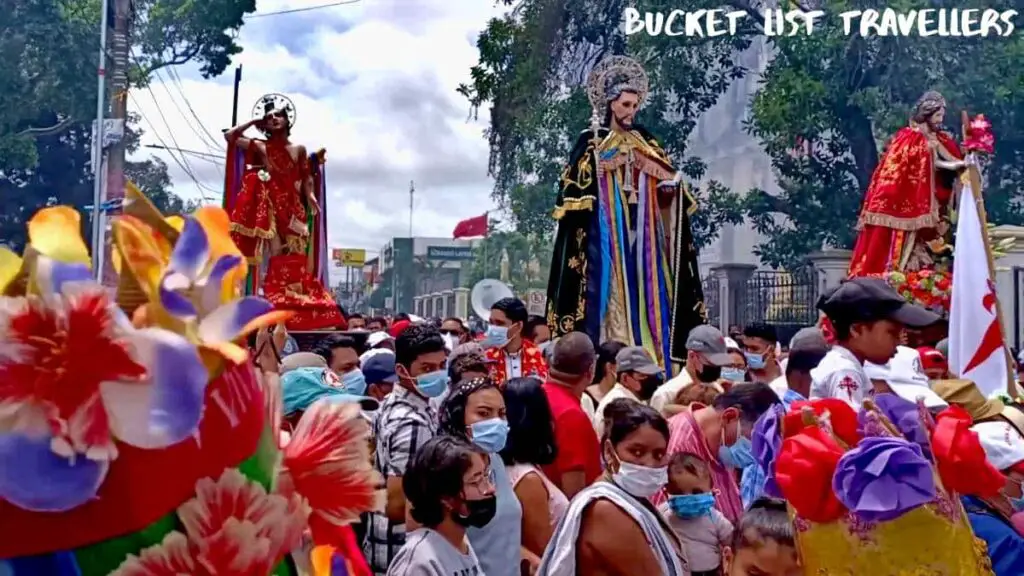
San Sebastián
The patron saint of Diriamba is San Sebastián or Saint Sebastian. Saint Sebastian an early Christian preacher and martyr that lived around 200AD. During a time of Christian persecution, San Sebastian died by arrow.
San Marcos Evangelista
The patron saint of San Marcos is San Marcos Evangelista or Saint Mark. Saint Mark is considered the author of the Gospel of Mark in the Christian Bible.
San Santiago
The patron saint of Jinotepe is San Santiago. He is also known as Saint James and Santiago Apóstol. San Santiago was one of Jesus’ 12 disciples. The statue of Saint James holds the pilgrim’s staff in one hand and the Holy Scriptures in the other. Saint James was a Christian martyr that died by beheading.
The real life saints San Santiago and San Sebastián never met in person. Their meeting for El Tope de los Santos is in honour of the two statues both arriving by ship at the same time.
What happens at the Nicaraguan festival Tope de los Santos?
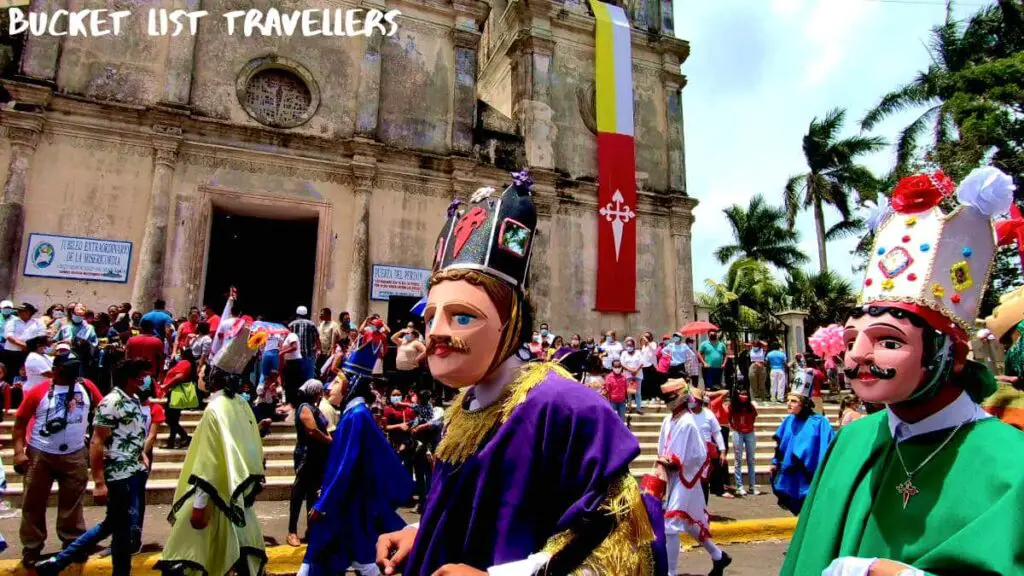
Mass
The festivities start with a mass in the main church of the town of the patron saint being honoured. In January it is Diriamba, in April it’s San Marcos and in July it’s Jinotepe.
For the Jinotepe Tope de los Santos, the festivities start at 10am on the 24th of July. The festival commences with a mass at the parish church Parroquia Santiago Apóstol. After the mass a life size statue of San Santiago leaves the church. It is then paraded along a road known as the Santa Rosa benefication road towards San Marcos. Along the way he runs into a life size statue of San Marcos Evangelista. San Marcos waits for him, carried on the shoulders of some of his parishioners. Traditionally the statues of the saints were paraded on a horse. However nowadays they carried by the faithful. The people that carry the statues are either volunteers or are chosen for the honour.
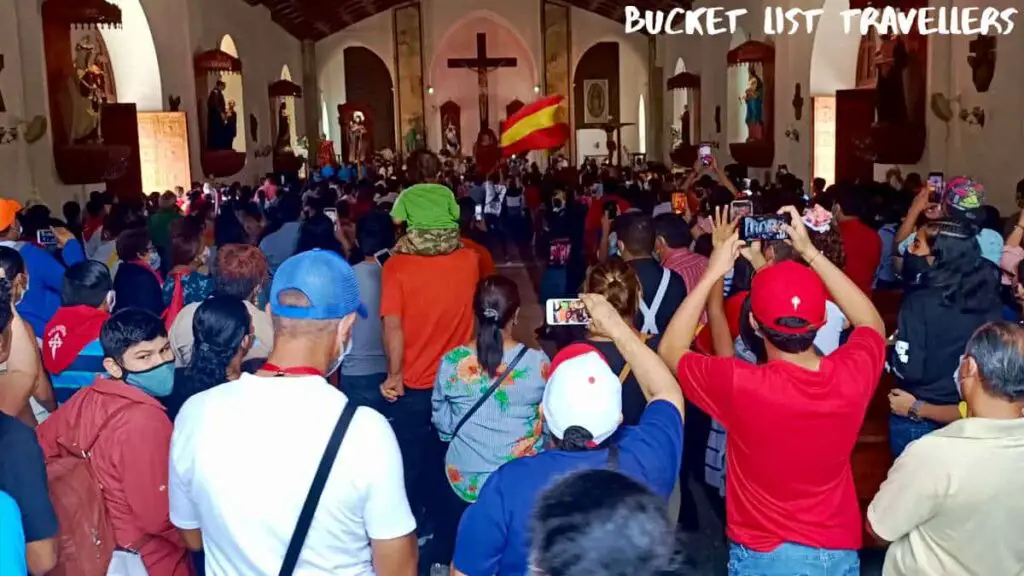
Parade of the Saints
The two statues then proceed to the town of Dolores where they run into the statue of San Sebastián. The saints are accompanied by people from the different neighbouring municipalities. They celebrate together in honour of Santiago Apostol. The images of the saints are accompanied by representative dances of each municipality. Dances include los Diablitos, la Muerte Quierina, el Toro Huaco, la Vaquita, el Güegüense or Macho Ratón, el Viejo y la Vieja, el Gigante, las Inditas del Guacal, las Húngaras.
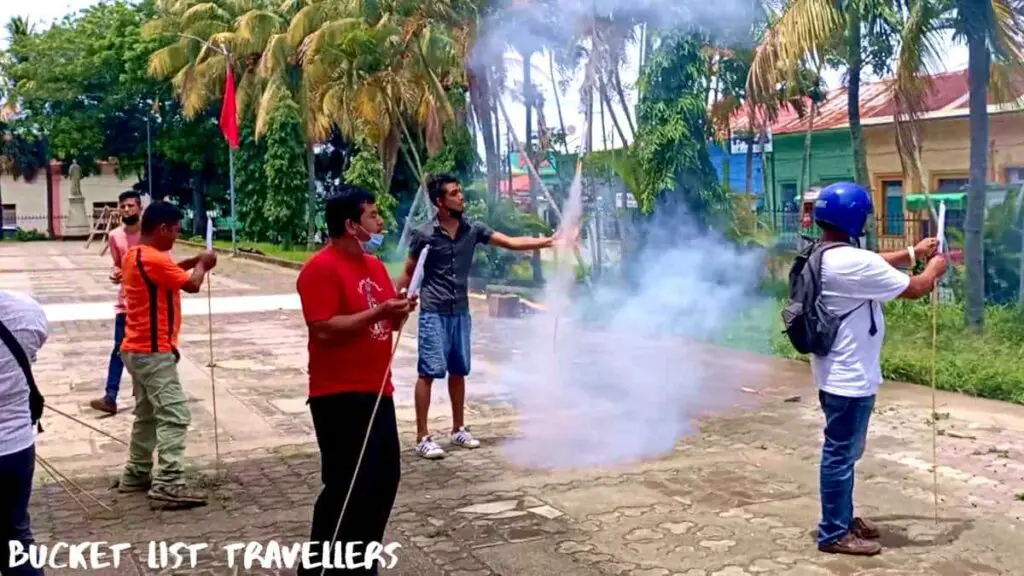
Music, fireworks and food
Along with the dances by people wearing traditional costumes, the festivities also include plenty of music, fireworks (also known as bombas) as well as the handing out of favours in the form of food and drinks. Traditional food and drinks handed out include ajiaco, nacatamales, stew, bunuelos, ginger beer and corn.
Dance performances
As part of the festivities, the Mayor’s Office of Jinotepe installs a stage where folk groups and marimbas perform. The Municipal Mayor’s Office also puts on a fireworks display on the night of the 24th.

Eurcharist
On the morning of 25th of July, the festivities start wtih a Eucharist or Holy Communion. This occurs at Parroquia Santiago Apóstol. Following the Eucharist there are more festivities. After the service the church bells ring and the statues make their way out of the church. The statues dance from side to side while people wave flags for each city council for the three saints.
Festival safety
The Red Cross, Fire Department and the National Police are usually in attendance. They are there to look after the crowd.
When we saw the parade in 2021, there were a few changes to the festivities. The festivities started just before 9am on the 24th of July when Santiago ran into San Marcos very close to Los Chocoyiitos park. San Marcos then runs into San Sebastian, patron of Diriamaba in front of the Municipal Palace. San Sebastian meets him after being transferred by his porters from Las Banderas park to the historic centre of the city.
History of the Nicaraguan festival Tope de los Santos
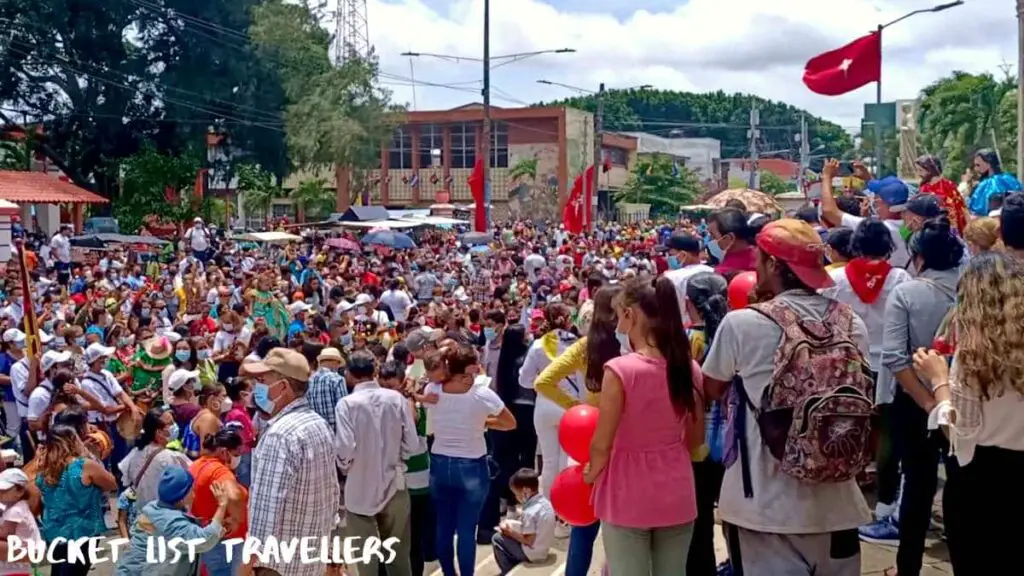
According to legend, Tope de los Santos started in the first half of the 18th century. This occurred after the statues of San Sebastian and San Santiago arrived in Nicaragua. The statues had been on a boat from Spain and were heading to Peru when a storm hit. Fearing that the boat would capsize, the crew threw 2 heavy boxes containing these statues overboard. Legend has it, once the boxes hit the water the storm dissipated and the boxes ended up on the shores of Nicaragua.
Local folklore regarding Tope de los Santos
Local fishermen found the boxes containing the images of San Santiago and San Sebastian at La Sanja de Ambar in Huehuete in Jinotepe. They opened the first box and found the statue of San Sebastián Mártir with the name Jinotepe inscribed. The other box contained the statue of Santiago Apóstol and had the name Diriamba.
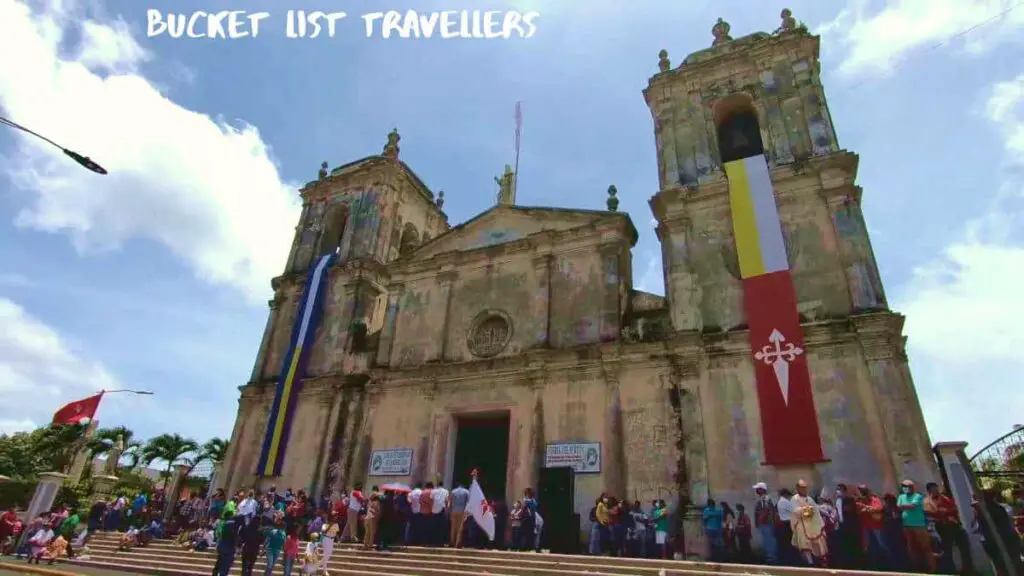
The fishermen loaded the two statues onto ox carts and transported them to their respective cities. However the next day mysteriously the boxes had been switched. San Sebastián was in Diriamba and Santiago in Jinotepe. The fishermen returned the statues to their original locations. However the same thing happened again. The pastor of Jinotepe took this as a sign that Santiago belonged in Jinotepe and San Sebastián in Diriamba. They decided that on the day before the feast of the patron saint each one would go to visit the other. They would meet halfway at the town of Dolores. This is how the Tope de los Santos began.

The inclusion of San Marcos in Tope de los Santos
Some time later San Marcos was added to the festivities. This was after a priest had a vision that the city of San Marcos would be destroyed by an earthquake. During this time the priest prayed to San Marcos to spare the city. Because the city was not destroyed by an earthquake, the city was named after San Marcos. Furthermore, San Marcos is now its patron saint and is part of the Tope de los Santos festivities.
The inclusion of the Virgin of Montserrat in Tope de los Santos
Recently the Virgin of Montserrat, the patron of La Concepción was also added to the festivities. However some traditionalists argue that the original tradition should remain intact.
Nicaraguan traditional dances at Tope de los Santos
Many traditional Nicaraguan dances have themes around mocking the Spanish colonial authorities. The costumes are often bright and vibrant and dancers are accompanied by musicians.
Los Diablitos
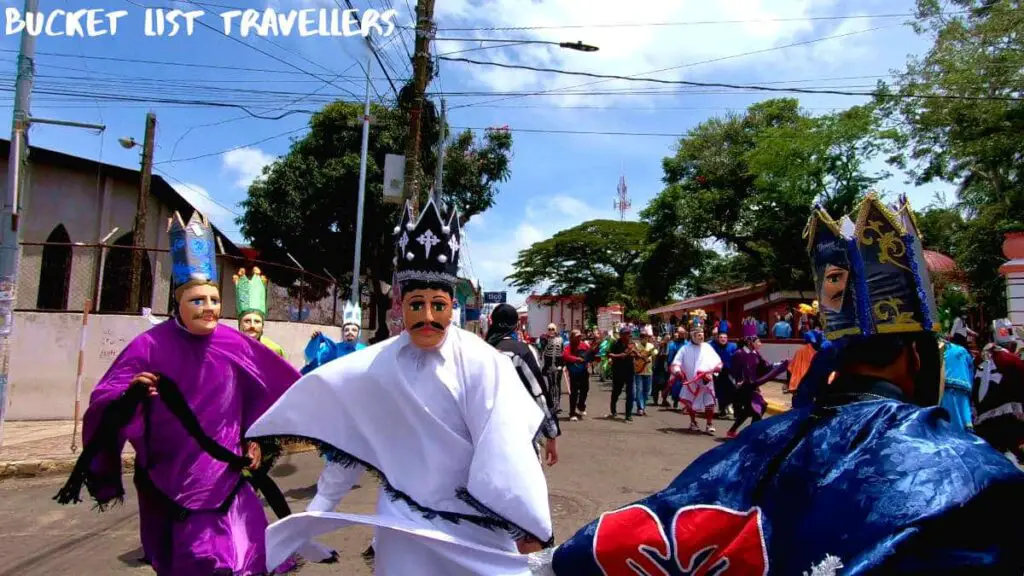
The regional folk dance Los Diablitos is three or four centuries old. This satirical dance mocks Spanish colonisers. The dancers portray lost souls, punished their sins. The dancers dress in colourful costumes as European pageboys with a porcelain mask that has blue eyes and European features. The costumes feature a crown or hat, a cape, shorts, shoes, socks and a handkerchief on their heads. In their hands are a piece of cloth or a small towel which is sometimes placed on the nape of the neck during the dance. They wear cardboard or paper maché crowns, decorated with glitter, colourful paper, mirrors and other ornaments. Some of their capes display religious symbols and words such as “Viva Santiago”.
La Muerte Quirina
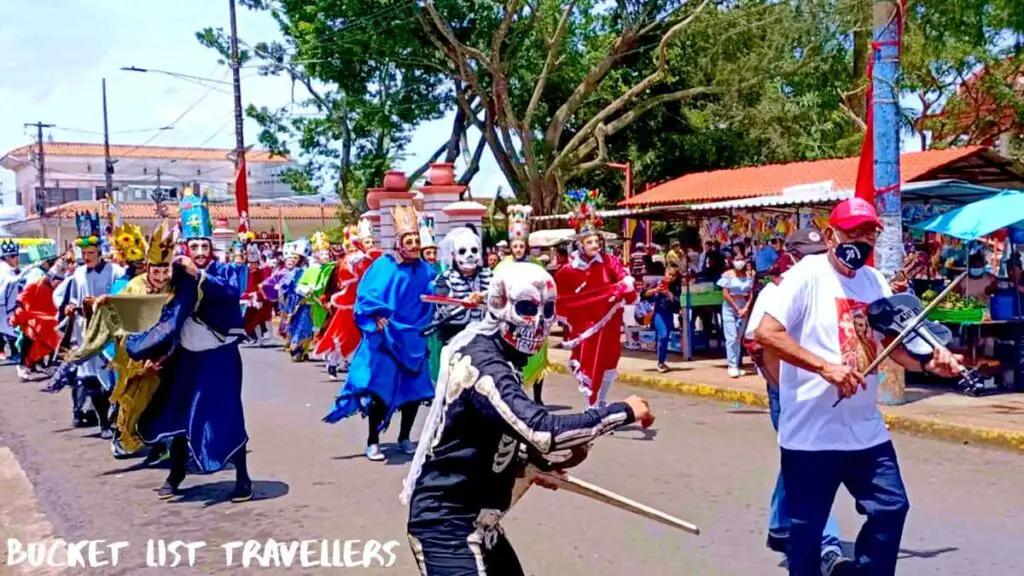
These dancers dress as skeletons and symbolise death. They carry scissors in their hands which they snap as they dance to separate the public from the other dancers.
El Toro Huaco
El Toro Huaco is performed by two groups of dances with eight to twelve people each as well as another dancer that is known as the “Mandador” – the leader of the dance – and an artificial “bull” which is represented by a person carrying a bull’s head mounted on a frame. This dance often begins the parade in Diriamba, leading the statue of San Sebastián through the city. During the performance the dancers greet each other by miming whispering in each other’s ear. The dancers in the two groups wear wooden masks and the dancer holding the bull’s head doesn’t wear a mask. During the dance the “bull” sometimes attacks the other dancers, who in turn defend themselves with a box that they carry in their left hand.
La Vaquita
La Vaquita is a dance performed by a woman in a traditional costume which depicts a lady calf. It has its origin in the patron saint festivities of Managua. The costume consists of a hooped skirt with either a statue or a picture of a crowned cow’s head. The lady calf also wears a hairstyle adorned with flowers. A traditional dance is performed and the lady calf interacts with other dancers. In the dance she dances as though she were going to fight, while the women dancers try to escape from her.
El Güegüense or Macho Ratón
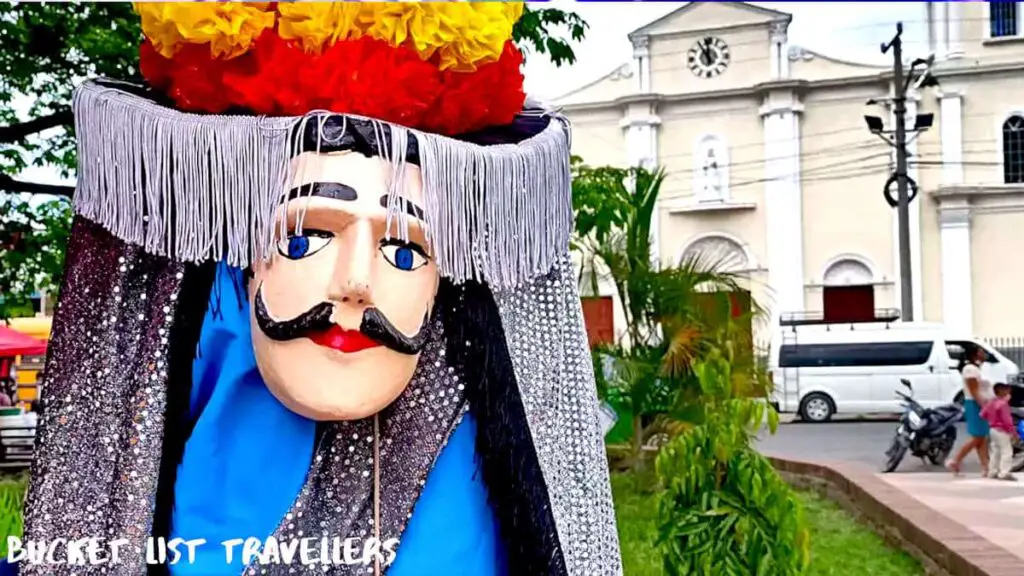
The most famous Nicaraguan satirical folklore play is El Güegüense, also known as Macho Ratón. This play is performed during the feast of San Sebastián. In the play, a wise elder called El Güegüense mocks Spanish colonial authority by seeming to comply while using clever wordplay to undermine their authority. The play features 14 characters – 3 indigenous mestizos, 4 Spanish authorities, 3 women and 4 beasts of burden (depicted as horses).
El Viejo y la Vieja
This is a dance performed during the San Sebastián festivities. The dancers are dressed as old people with porcelain masks. The man carries a cane and a cigar and the woman wears and hat and colourful clothing and carries a handkerchief in her hand. They dance to the sound of a whistle and drum or to the marimba and the dance satirises longevity.
El Gigante
This is another traditional dance from Diriamba and represents the Biblical story of David and Goliath.
Las Inditas del Guacal
This regional dance comes from Masaya and the dancers are dressed in white dresses representing doves. They represent a message of peace and the dance symbolises the act of doves flying when the Inditas raise the hem of their costumes up to their shoulders.
Las Húngaras
This translates to The Hungarian Dance and has its roots in gypsy culture. This is danced to the marimba. The female dancers wear a brightly coloured flowered skirt and blouse and carries a tambourine in her right hand. The male dancers wear dark trousers tucked into the boots and a white or coloured shirt with a vest decorated in sequins or beads. The dance is in honour of the gypsy circus performers who wear able to copy the steps of the Nicaraguan marimba dances.
Getting to Tope de los Santos
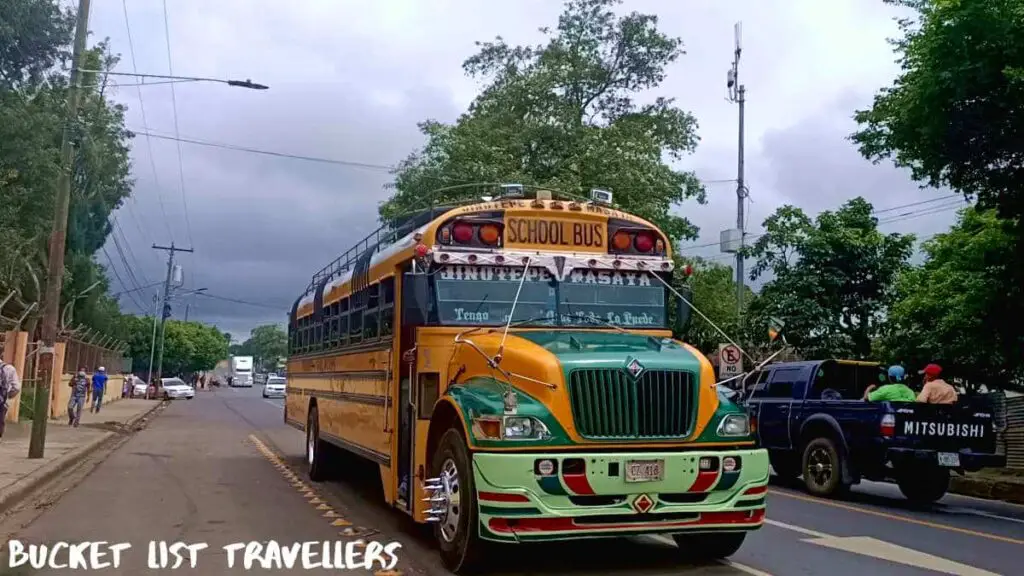
Jinotepe, San Marcos and Diriamba are all very walkable cities and there are colourful local buses as well as minibuses that connect these cities to larger hubs such as Managua, Masaya and Granada. We travelled to Jinotepe from Managua by minibus and it took about an hour and a half and cost 40 cordobas per person.
How long to spend at Tope de los Santos
Tope de los Santos starts in the morning and a couple of hours should be sufficient for getting a good taste of the festivities. The Tope de los Santos usually forms part of a larger festival celebrating the patron saint which goes for around a week.
Where to stay when visiting Tope de los Santos
There are a number of hotels in Jinotepe. We stayed in an Airbnb on a farm just outside Jinotepe called Finca Guanacaste. We enjoyed being a little bit outside the hustle and bustle of the city and there were even monkeys in our back yard!
Is Tope de los Santos safe?
As with any large gathering in Nicaragua, be ware of pick pockets and petty theft.
Other general safety considerations for travel in Nicaragua:
- Drinking water – The tap water in Jinotepe is safe to drink
- Mosquitoes – Mosquitoes are prsesent in Jinotepe, but we didn’t find them as aggressive as in other parts of Nicaragua
- Road safety – The roads around Jinotepe are paved and in good condition. Take normal safety precautions when on the road
- Sun safety – The UV Index is very high in Central America. Sun protection such as sunscreen, a hat and sunglasses is very important to ensure you don’t get burnt.
- Dogs – In many countries in Central America, stray dogs are common. For more on dog safety while travelling, check out this video.
As with any destination, take all of your normal safety precautions.
Final thoughts on Tope de los Santos
If you want to see Tope de los Santos in action, check out our Tope de los Santos video.
Nicaragua Blogs
You can find our Nicaragua blogs below.
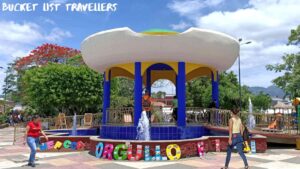
Esteli Nicaragua Destination Guide (2024): What You Need to Know
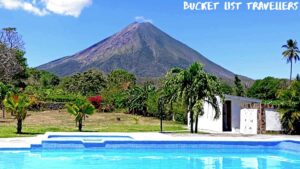
Ometepe Island Nicaragua Destination Guide (2024): What You Need to Know
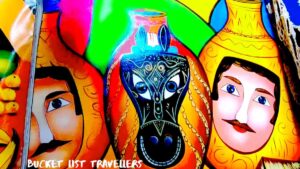
Masaya Nicaragua Destination Guide (2024): What You Need to Know
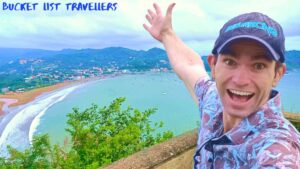
San Juan del Sur Nicaragua Destination Guide (2024): What You Need to Know
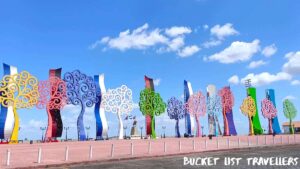
Managua Nicaragua Destination Guide (2024): What You Need to Know

Leon Nicaragua Destination Guide (2024): What You Need to Know
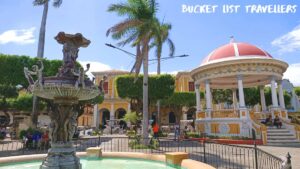
Granada Nicaragua Destination Guide (2024): What You Need to Know
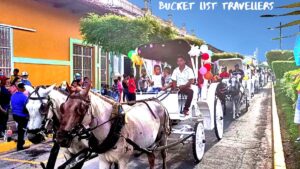
Transport in Nicaragua – Complete Guide to Nicaragua Transportation (2024)

Where should I live in Nicaragua?
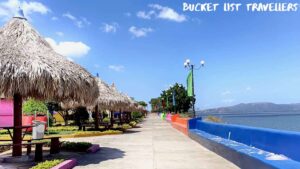
Top 5 Things to do in Managua Nicaragua (2024)
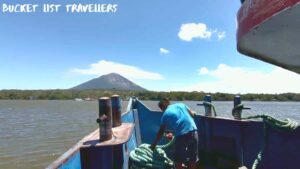
Granada Ferry: How to get to Ometepe Island

Nicaragua Costa Rica Border Crossing: Complete Travel Guide
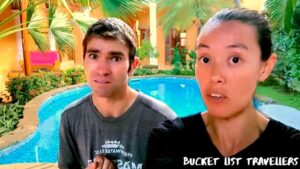
Home Invasion in Granada Nicaragua

Ojo de Agua: Paradise in Nicaragua!
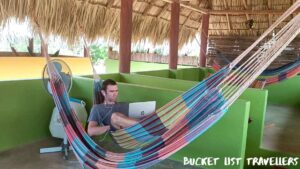
How Good is the Internet in Nicaragua?
Affiliate Links
This website contains affiliate links, which means we may earn a commission on any purchases at no additional cost to you. Your support helps us continue our travels and make more travel blogs and travel videos, thank you!
